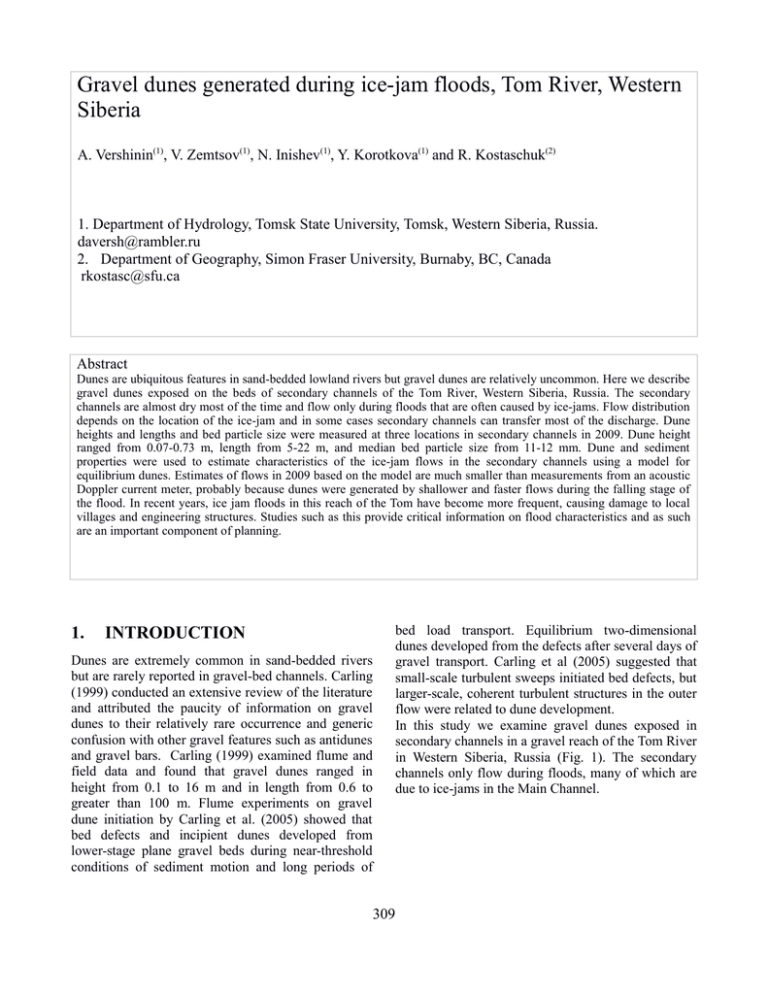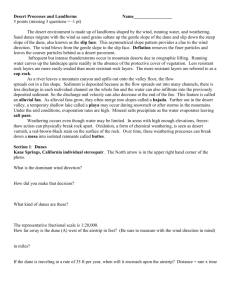Gravel dunes generated during ice-jam floods, Tom River, Western Siberia
advertisement

Gravel dunes generated during ice-jam floods, Tom River, Western Siberia A. Vershinin(1), V. Zemtsov(1), N. Inishev(1), Y. Korotkova(1) and R. Kostaschuk(2) 1. Department of Hydrology, Tomsk State University, Tomsk, Western Siberia, Russia. daversh@rambler.ru 2. Department of Geography, Simon Fraser University, Burnaby, BC, Canada rkostasc@sfu.ca Abstract Dunes are ubiquitous features in sand-bedded lowland rivers but gravel dunes are relatively uncommon. Here we describe gravel dunes exposed on the beds of secondary channels of the Tom River, Western Siberia, Russia. The secondary channels are almost dry most of the time and flow only during floods that are often caused by ice-jams. Flow distribution depends on the location of the ice-jam and in some cases secondary channels can transfer most of the discharge. Dune heights and lengths and bed particle size were measured at three locations in secondary channels in 2009. Dune height ranged from 0.07-0.73 m, length from 5-22 m, and median bed particle size from 11-12 mm. Dune and sediment properties were used to estimate characteristics of the ice-jam flows in the secondary channels using a model for equilibrium dunes. Estimates of flows in 2009 based on the model are much smaller than measurements from an acoustic Doppler current meter, probably because dunes were generated by shallower and faster flows during the falling stage of the flood. In recent years, ice jam floods in this reach of the Tom have become more frequent, causing damage to local villages and engineering structures. Studies such as this provide critical information on flood characteristics and as such are an important component of planning. 1. INTRODUCTION Dunes are extremely common in sand-bedded rivers but are rarely reported in gravel-bed channels. Carling (1999) conducted an extensive review of the literature and attributed the paucity of information on gravel dunes to their relatively rare occurrence and generic confusion with other gravel features such as antidunes and gravel bars. Carling (1999) examined flume and field data and found that gravel dunes ranged in height from 0.1 to 16 m and in length from 0.6 to greater than 100 m. Flume experiments on gravel dune initiation by Carling et al. (2005) showed that bed defects and incipient dunes developed from lower-stage plane gravel beds during near-threshold conditions of sediment motion and long periods of 309 bed load transport. Equilibrium two-dimensional dunes developed from the defects after several days of gravel transport. Carling et al (2005) suggested that small-scale turbulent sweeps initiated bed defects, but larger-scale, coherent turbulent structures in the outer flow were related to dune development. In this study we examine gravel dunes exposed in secondary channels in a gravel reach of the Tom River in Western Siberia, Russia (Fig. 1). The secondary channels only flow during floods, many of which are due to ice-jams in the Main Channel. 2. current profiler (aDcp) has been used since 2008. Dune length and height were measured at three Sites (Fig. 1) with a total station after an ice-jam flood in 2009. Sediment samples were collected at each Site and analyzed using sieves. flows using the model of van Rijn (1984). Flow depth, h, was determined from dune length, λ : METHODS Discharge in the Main and secondary channels in the study reach has been measured from a research launch since 1984. A 1000 kHz Sontek acoustic Doppler Dune and sediment properties were used to estimate paleohydraulic and paleohydrologic properties of the λ=7.3 h s= ρs / ρ and ν is the kinematic where viscosity of water. Mean flow velocity, U , is determined from the bed shear stress due to skin friction using the quadratic stress equation: [1] and dune height, ∆ , was used to determine bed shear stress due to skin friction: ( )( 0.3 D ∆=0.11 h 50 h − 0.5T 1−e ) ( 25 −T ) [2] τ 0= ρC D U [7] where D50 is median bed particle size and T is the transport stage parameter for skin friction: ( T= τ 0 − τ cr τ cr where ) C D= 0.3 +0.055 ( 1 − e− 0.02 D 1+1.2 D❑ ❑ C=18 log where ) [5] where g is the acceleration of gravity, ρs is sediment density, and ρ is water density. Dimensionless grain size, D ❑ is: [ [10] and D 90 is the 90th percentile of the bed particle size distribution. τ cr g ( ρ s − ρ ) D50 g ( s −1 ) ν2 k s is the grain roughness: k s=3 D 90 θ cr is: D❑= ( ) 12 h ks [9] [4] θ cr = g 2 C and C is the Chezy coefficient for skin friction: where τ 0 is the bed shear stress due to skin friction and τ cr is the threshold bed shear stress for sediment motion. Threshold bed shear stress was determined from the threshold Shield’s parameter, θ cr , using the equation of Soulsby (1997): where C D is the drag coefficient: [8] [3] θ cr = 2 ] 1/ 3 D 50 [6] 310 Flows in the secondary channels generated gravel dunes at three locations in 2009 (Fig. 1, 3). Dunes have a long, gently-sloping stoss side and a short, steep (>30o) lee side (Fig. 4). Most of the dunes have slightly sinuous crests (Fig. 4) and can be classified as two-dimensional. The crestal areas of dunes often display scours caused by ice blocks. Figure 3. Field of gravel dunes in May 2012 at Site 2 on the Svetlaya Branch (Fig. 1). Flow was from top left to bottom right. Figure 1. Study reach of the Tom River. The numbers 1-3 refer to Sites of gravel dunes. The image was taken during low flow on October 9 2003. Image from Google Earth. 3. RESULTS AND DISCUSSION Ice-jam floods in the spring have occurred annually about 40% of the time over the period 1998-2011. Icejams in the reach follow three typical patterns (Fig. 2), Firstly, the obstruction occurs in the meander bend of the Main Channel (Fig. 2a). The ice accumulates in the Main Channel and extends upstream to the entrance to the Svetlaya Branch (Fig. 1, 2a). Flow in the Main Channel is diverted primarily into the Svetlaya Branch, which rejoins the Main Channel downstream of the bend. Secondly, ice accumulates at the downstream end of the Svetlaya Branch, diverting flow into the Kaltaikaya Branch (Fig. 1, 2b). Thirdly, ice accumulates in the Main Channel and blocks the entrance to the Svetlaya (Fig. 1, 2c), diverting flow into the Pankova Branch and then the Kaltaikaya Branch (Fig. 1, 2c). The ice is eventually flushed through the reach and all of the channels are actively flowing (Fig. 2d). Figure 4. Gravel dune in May 2012 at Site 2 on the Svetlaya Branch (Fig. 1). Flow was from the left. Table 1 summarizes mean values of measurements of dune geometry and bed particle size for Sites 1-3 in 2009. Table 2 presents flow characteristics estimated from dune and sediment properties using the van Rijn (1984) models, and Table 3 provides results from aDcp measurements on May 7 2009 just after the icejam. Site 1 2 3 λ (m) 17.5 6.4 11 ∆ (m) 0.61 0.14 0.18 D50 (m) 0.012 0.011 0.012 D90 (m) 0.023 0.017 0.015 Table 1. Mean dune length (λ) and height (∆), and median (D50) and coarse fraction (D90) bed particle size for 2009. 311 Site 1 2 3 h (m) 2.4 0.88 1.5 U (m/s) 2.37 1.67 1.85 W (m) 118 463 255 Q (m3/s) 670 678 711 Table 2. Mean flow depth (h), velocity (U), channel width (W) and discharge (Q). W was measured from the 2010 satellite image taken just after the ice-jam (Fig. 2). h and U were estimated from the van Rijn (1984) models using the 2009 dune and particle size measurements (Table 1). Site 1 2 3 h (m) 5.0 5.6 7.3 U (m/s) 1.07 1.61 0.71 W (m) 117 330 267 Q (m3/s) 670 2966 1381 λ , and height, ∆ , for Sites Table 3. Mean flow depth (h), velocity (U), channel width (W) and discharge (Q) measured using an aDcp on May 7 2009. Figure 5. Dune length, 1-3 in 2009. Dunes were largest in the Pankova Branch (Site 1), followed by the Kaltaikaya (Site 3) and the Svetlaya (Site 2). Bed particle size was similar at all Sites (Table 1). Flow depth is smaller and mean velocity is larger when estimated from the van Rijn models (Table 2) compared to the aDcp measurements (Table 3). Width measured from the 2010 satellite image (Table 2) is greater than the aDcp measurement in 2009 (Table 3) because aDcp measurements are limited to deeper sections of the channel, or because the satellite image was taken during a higher flood stage in 2010 compared to 2009. Discharge estimated from the van Rijn models (Table 2) is consistent for all three Sites but is much less than the aDcp measurements (Table 3). The aDcp measurements were taken when all of the channels were actively flowing in 2009 and the ice had been removed from the reach. Discharge measured from the aDcp is highest in the largest channel, Svetlaya, followed by the Kaltaikaya and the Pankova. Carling (1999) found that dune length and height for three-dimensional gravel dunes had an exponent similar to that of Ashley (1990) and he concluded that they were probably in equilibrium with the flow. Carling (1999) also suggested that the twodimensional gravel dunes that he examined were not in equilibrium. The flume experiments of Carling et al. (2005) however showed that, given sufficient time, near-equilibrium two-dimensional dunes can develop. The exponent for the two-dimensional Tom gravel dunes (Fig. 5) is larger than of the Ashley (1990) relation, suggesting that the dunes may not be in equilibrium. It must be noted however that scour by ice blocks may affect the relation on Fig. 5. It is also possible that the Ashley (1990) function for sand dunes does not apply to equilibrium gravel dunes. The results summarized on Tables 1-3 indicate that the dunes measured in 2009 were generated by much shallower and faster flows than those measured with the aDcp. It may be that the flows that created the dunes occurred during the falling stages of the flood when the depth was lower and the velocity higher. It is also possible that the dunes are non-equilibrium features. A compilation of a large amount of data for sand dunes and ripples by Ashley (1990) showed that dune length ( λ ) and height ( ∆ ) were related as a power function of the form: [11] ∆=0.0677 λ 0.8098 Ice-jam floods are common in the Tom River of Western Siberia. Flow distribution between the Main and secondary channels depends on the location of the ice-jam and in some cases secondary channels can transfer most of the flow. Gravel dunes are exposed on the beds of secondary channels during low flows. Dune and sediment properties measured in 2009 were used to estimate characteristics of the ice-jam flows in the secondary channels using a sediment transport model. Estimates of flows in 2009 based on dunes are much smaller than acoustic Doppler current meter measurements during ice-jam flood flows, probably because the dunes were generated by of shallower and 312 4. CONCLUSIONS faster flows during the falling stage the flood. Ice jam floods in the Tom have become more frequent in the past decade, causing damage to local villages and engineering structures. An improved understanding of ice-jam flood characteristics is critical for planning. 5. 6. REFERENCES Ashley, G.M. 1990. Classification of large-scale subaqueous bedforms - a new look at an old problem. Journal of Sedimentary Petrology: 60, 160–172. Carling, P.A. 1999. Subaqueous gravel dunes. Journal of Sedimentary Research: 69, 534-545. Carling, P.A., Richardson, K & Ikeda, H. 2005. A flume experiment on the development of subaqueous finegravel dunes from a lower stage plane bed. Journal of Geophysical Research: 110, F04S05, doi:10.1029/2004JF000205. Soulsby, R. 1997. Dynamics of Marine Sands: A Manual for Practical Applications. Thomas Telford, London, 249 p. van Rijn, L.C. 1984. Sediment transport: Parts I-III. Journal of Hydraulic Engineering: 110, 1431-1454. ACKNOWLEDGMENT We would like to thanks students and staff in the Department of Hydrology, Tomsk State University, for their able assistance. Funding was provided by the Russian Foundation for Basic Research (Grant 10-0500625a) and the Natural Sciences and Engineering Research Council of Canada. 313 Figure 2. Typical patterns of ice-jam flooding in the study reach of the Tom River. Ice is indicated in white. See text for explanation. 314






